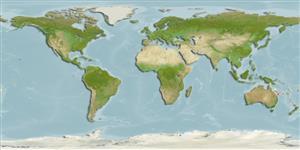Elasmobranchii (sharks and rays) >
Carcharhiniformes (Ground sharks) >
Pentanchidae (Deepwater catsharks)
Etymology: Figaro: Presumably named for the eponymous barber in various dramas (e.g., The Marriage of Figaro), allusion not explained nor evident. (See ETYFish); striatus: Latin for grooved or furrowed (authors say “striped,” referring to its striped color pattern. (See ETYFish).
More on authors: Gledhill, Last & White.
Environment: milieu / climate zone / depth range / distribution range
Ecology
Marine; bathydemersal; depth range 300 - 419 m (Ref. 76950). Tropical
Western Pacific: Australia.
Size / Weight / Age
Maturity: Lm ? range ? - 38 cm
Max length : 42.1 cm TL male/unsexed; (Ref. 76950); 36.9 cm TL (female)
Short description
Identification keys | Morphology | Morphometrics
A very small species of catshark with the following characters: head in dorsoventral view narrowly parabolic, short 17.2-19.6% TL; small eye, its length 3.4-3.9% TL, 1.73-2.03 in snout, dorsolaterally located; well developed labial furrows , extending well beyond corners of mouth, lower furrow is slightly longer than the upper one; first dorsal fin is slightly smaller than the second one; small pelvic fins, slender, length 8.8-11.3% TL; posterior portion strongly directed posterodorsally (forming a small lobe, enveloping partly the proximo-lateral margin of clasper); strongly convex inner margin, forming a partial apron and connected to clasper dorsomedially near its base, soft tissue connecting insertions of pelvic fins is weak, not forming a prominent apron overlying ventral surface of tail; a much longer anal-fin base than second dorsal fin, base 9.9-10.9% TL, 2.4-6.0 times anal-caudal space; long caudal peduncle, anal-caudal space 1.6-4.2% TL; crest of enlarged denticles on anterior dorsal caudal-fin margin extending from about over origin of ventral caudal-fin lobe to almost mid-length of dorsal caudal-fin margin; crest of enlarged denticles originating at mid-point of caudal peduncle, extending to elevated part of ventral lobe; size at maturity for at about 38.0 cm TL; preserved color pale brown dorsally, with dark saddles and bars, lighter ventrally; pre-dorsally with about 4 larger saddles; saddles present below and between dorsal fins and extending onto caudal, these are rarely larger than eye diameter; larger saddles are pale edged, separated by narrower, less distinct bars; saddles rarely extending below the lateral midline; 35-38 monospondylous vertebrae; 85-93 precaudal; 140-149 in total (Ref. 76950).
Life cycle and mating behavior
Maturities | Reproduction | Spawnings | Egg(s) | Fecundities | Larvae
Gledhill, D.C., P.R. Last and W.T. White, 2008. Resurrection of the genus Figaro Whitley (Carcharhiniformes: Scyliorhinidae) with the description of a new species from northeastern Australia. In Last, P.R., White, W.T. & Pogonoski, J.J. (eds.): Descriptions of New Australian Chondrichthyans. CSIRO Marine and Atmospheric Research Paper no. 22. (Ref. 76950)
IUCN Red List Status (Ref. 130435)
Threat to humans
Harmless
Human uses
Tools
Special reports
Download XML
Internet sources
Estimates based on models
Preferred temperature (Ref.
123201): 7.1 - 17.4, mean 13 °C (based on 20 cells).
Phylogenetic diversity index (Ref.
82804): PD
50 = 0.7500 [Uniqueness, from 0.5 = low to 2.0 = high].
Bayesian length-weight: a=0.00355 (0.00176 - 0.00714), b=3.09 (2.91 - 3.27), in cm total length, based on LWR estimates for this (Sub)family-body shape (Ref.
93245).
Trophic level (Ref.
69278): 4.0 ±0.6 se; based on size and trophs of closest relatives
Resilience (Ref.
120179): Low, minimum population doubling time 4.5 - 14 years (Preliminary low fecundity).
Fishing Vulnerability (Ref.
59153): Low to moderate vulnerability (32 of 100).
